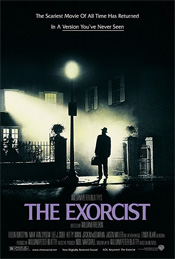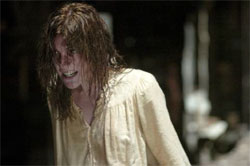The new supernatural horror flick The Rite, opening Friday and starring Anthony Hopkins, is the latest in a long line of Hollywood films in the subgenre inaugurated by William Friedkin’s 1973 landmark film The Exorcist. Movies had explored exorcism before 1973, but Friedkin’s film spotlighted the phenomenon in an unprecedented way.

The Exorcist represents a pivotal link between the Catholic-inflected piety of Golden Age Hollywood and the demonic world of latter-day horror. It is also the source of much of our culture’s awareness of and ideas about possession and exorcism. Real exorcisms in both Catholic and Protestant milieus proliferated in the film’s wake, and its impact continues to be felt in recent films.
The form of exorcism used in The Exorcist is from the Roman Ritual of 1614, which remained unchanged until updates in 1999 and 2004. The film’s depiction of the rite and phenomenon of possession, though sensationalized, is fairly authentic. Notable elements include the demon’s resistance to exorcism and other ambiguities. For example, the victim writhes in pain when a priest sprinkles her with water—though it is not blessed holy water. Placebo effect? Or is the demon deliberately casting doubt on the reality of the possession, the effectiveness of the church’s arsenal, or both?
Casting out demons goes back to the ministry of Jesus, and in cinema, back to the silent era. The 1912 film From the Manger to the Cross depicts Jesus healing a demoniac. Cecil B. DeMille’s silent The King of Kings (1927) opens with Jesus dramatically delivering Mary Magdalene of seven demons.
Although the Devil and satanic cults surfaced in films prior to The Exorcist, possession and efforts to cast out demons were rare. But by the late 1960s, the pious certainties of Golden Age Hollywood had crumbled, and a sophisticated jadedness prevailed. Mia Farrow, carrying the Devil’s child in Rosemary’s Baby (1968), flips through the Easter 1966 issue of Time magazine with the cover question “Is God Dead?” By the end, neither God nor his agents has intervened, and the Devil is victorious. The Omen (1976) likewise ends with heaven defaulting while hell triumphs.
Various Exorcist sequels failed theologically as well as artistically to match the original. Exorcist II: The Heretic (1977) floated some bizarre ideas: Catholic leadership distances itself from belief in Satan’s existence, while the late Father Merrin seems to have been transformed into a New Age disciple of the censured Jesuit mystic Pierre Teilhard de Chardin. In The Exorcist III (1990), the demon of the first two films takes further revenge against Merrin by reanimating his body with the soul of a murderer. In both films, exorcism was depicted in essentially magical terms rather than as spiritual warfare.
Dominion: Prequel to the Exorcist (2005) attempts to match the spirit of the original. Directed by Paul Schrader (a Calvin College alumnus), it recounts Merrin’s first encounter with the demon in Kenya. Schrader’s pensive, theological approach didn’t match studio expectations, and the film was reworked by Renny Harlin as a more typical horror show called Exorcist: The Beginning (2004).

At about the same time came two films based on the real-life case of a young Bavarian woman named Anneliese Michel: Scott Derrickson’s The Exorcism of Emily Rose (2005) and Hans-Christian Schmid’s Requiem (2006). What distinguishes both of these sober, restrained films is their ambiguity: Is it demonic possession or mental illness? Derrickson takes a forensic approach while Schmid uses a quasi-documentary style.
Taking the documentary angle further, the 2010 mockumentary The Last Exorcism offers a Blair Witch/Paranormal Activity spin on the material, in which a disillusioned non-denominational pastor who no longer believes in God agrees to participate in a documentary in order to expose exorcism as a sham.
As for The Rite (our review will post Friday), allegedly “inspired by true events,” Hopkins plays a priest who literally has a devil of a fight on his hands.
Steven D. Greydanus, host of DecentFilms.com, is a film critic for Christianity Today and the National Catholic Register.
Copyright © 2011 Christianity Today. Click for reprint information.










